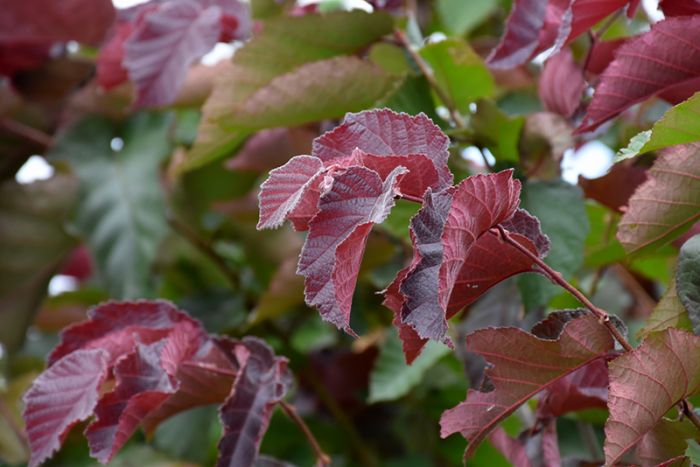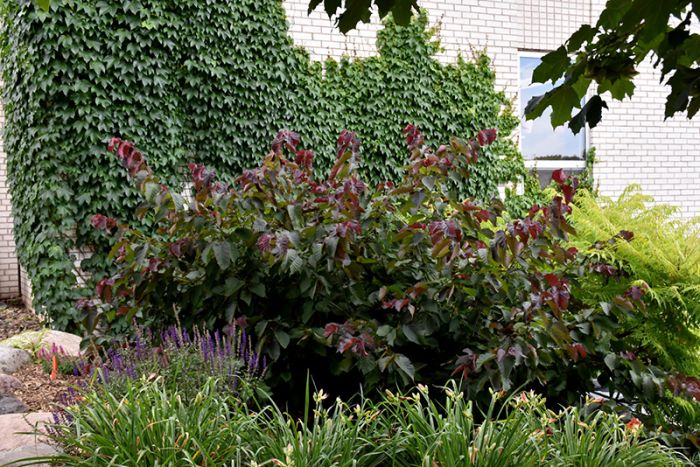Corylus, American Hazelnut Shurb 'Purpleleaf Bailey Select'


Out of stock
- Sun Preference
- Full-Sun, Part-Sun
Description
A mature selection featuring deep purple foliage. Low maintenance, tough shrub that is also great for wildlife.
Minnesota's Largest Selection of Shrubs
Elevate your landscaping with Gertens' unmatched variety of shrubs! Selecting the right shrubs for your backyard can enhance its beauty and functionality. Consider factors like sunlight, soil type, and mature size when choosing shrubs. For sunny areas, flowering shrubs like roses or hydrangeas can add color and charm. In shady spots, opt for shrubs like azaleas or hostas. Evergreen shrubs provide year-round interest and privacy, while deciduous shrubs offer seasonal color changes. At Gertens, we offer a wide selection of shrubs to suit every backyard need.
Details
Purpleleaf Bailey Select American Hazelnut | Corylus americana 'Purpleleaf Bailey Select'
Height: 8 feet
Spread: 8 feet
Sunlight: full sun to full shade
Hardiness Zone: 2b
Other Names: Bailey Select Purpleleaf Hazelnut
Brand: Bailey Nurseries
Description:
A pleasant large, spreading shrub with pest free, dark purple summer foliage turning burgundy in fall; produces tasty hazel nuts in clusters of 2 to 4; a good choice for naturalizing the landscape
Edible Qualities
Purpleleaf Bailey Select American Hazelnut is a medium-sized shrub that is typically grown for its edible qualities. It produces brown nuts which are usually ready for picking from early to mid fall. The nuts have a sweet taste.
The nuts are most often used in the following ways:
- Fresh Eating
Features & Attributes
Purpleleaf Bailey Select American Hazelnut has attractive purple-variegated forest green foliage with hints of burgundy which emerges deep purple in spring on a plant with an upright spreading habit of growth. The serrated pointy leaves are highly ornamental and turn burgundy in fall. It produces brown nuts in mid fall.
This is a dense multi-stemmed deciduous shrub with an upright spreading habit of growth. Its relatively coarse texture can be used to stand it apart from other landscape plants with finer foliage. This plant will require occasional maintenance and upkeep, and can be pruned at anytime. It is a good choice for attracting squirrels to your yard. Gardeners should be aware of the following characteristic(s) that may warrant special consideration;
- Suckering
Aside from its primary use as an edible, Purpleleaf Bailey Select American Hazelnut is sutiable for the following landscape applications;
- Hedges/Screening
- Naturalizing And Woodland Gardens
- Orchard/Edible Landscaping
Planting & Growing
Purpleleaf Bailey Select American Hazelnut will grow to be about 8 feet tall at maturity, with a spread of 8 feet. It tends to be a little leggy, with a typical clearance of 2 feet from the ground, and is suitable for planting under power lines. It grows at a medium rate, and under ideal conditions can be expected to live for approximately 30 years. While it is considered to be somewhat self-pollinating, it tends to set heavier quantities of fruit with a different variety of the same species growing nearby.
This plant is typically grown in a designated edibles garden. It performs well in both full sun and full shade. It is very adaptable to both dry and moist locations, and should do just fine under average home landscape conditions. It is considered to be drought-tolerant, and thus makes an ideal choice for xeriscaping or the moisture-conserving landscape. It is not particular as to soil type or pH. It is highly tolerant of urban pollution and will even thrive in inner city environments. This is a selection of a native North American species.
More Information
| Gerten Grown Plants | Gerten Grown Plants |
|---|---|
| Available for Pre-Order | No |
| Sun Preference | Full-Sun, Part-Sun |
| Mature Height (Range) | 5 - 10 feet |
| USDA Hardiness Zone | 3, 4, 5, 6, 7, 8, 9 |
| Common Family Name | Hazelnut |




